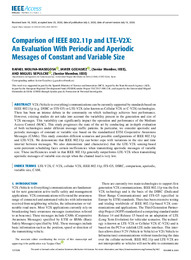Por favor, use este identificador para citar o enlazar este ítem:
https://hdl.handle.net/11000/30964Registro completo de metadatos
| Campo DC | Valor | Lengua/Idioma |
|---|---|---|
| dc.contributor.author | Molina Masegosa, Rafael | - |
| dc.contributor.author | Gozalvez, Javier | - |
| dc.contributor.author | Sepulcre, Miguel | - |
| dc.contributor.other | Departamentos de la UMH::Ingeniería de Comunicaciones | es_ES |
| dc.date.accessioned | 2024-02-02T09:55:54Z | - |
| dc.date.available | 2024-02-02T09:55:54Z | - |
| dc.date.created | 2020-07-03 | - |
| dc.identifier.citation | IEEE Access ( Volume: 8), 2020 | es_ES |
| dc.identifier.issn | 2169-3536 | - |
| dc.identifier.uri | https://hdl.handle.net/11000/30964 | - |
| dc.description.abstract | V2X (Vehicle to everything) communications can be currently supported by standards based on IEEE 802.11p (e.g. DSRC or ITS-G5) or LTE-V2X (also known as Cellular V2X or C-V2X) technologies. There has been an intense debate in the community on which technology achieves best performance. However, existing studies do not take into account the variability present in the generation and size of V2X messages. This variability can significantly impact the operation and performance of the Medium Access Control (MAC). This study progresses the state of the art by conducting an in-depth evaluation of both technologies under different message traffic patterns. In particular, we consider aperiodic and periodic messages of constant or variable size based on the standardized ETSI Cooperative Awareness Messages (CAMs). This study considers different scenarios and possible configurations of IEEE 802.11p and LTE-V2X. We demonstrate that IEEE 802.11p can better cope with variations in the size and time interval between messages. We also demonstrate (and characterize) that the LTE-V2X sensing-based semi-persistent scheduling faces certain inefficiencies when transmitting aperiodic messages of variable size. These inefficiencies result in that IEEE 802.11p generally outperforms LTE-V2X when transmitting aperiodic messages of variable size except when the channel load is very low. | es_ES |
| dc.format | application/pdf | es_ES |
| dc.format.extent | 23 | es_ES |
| dc.language.iso | eng | es_ES |
| dc.publisher | Institute of Electrical and Electronics Engineers | es_ES |
| dc.rights | info:eu-repo/semantics/openAccess | es_ES |
| dc.rights | Attribution-NonCommercial-NoDerivatives 4.0 Internacional | * |
| dc.rights.uri | http://creativecommons.org/licenses/by-nc-nd/4.0/ | * |
| dc.subject | LTE-V2X | es_ES |
| dc.subject | C-V2X | es_ES |
| dc.subject | cellular V2X | es_ES |
| dc.subject | ITS-G5 | es_ES |
| dc.subject | DSRC | es_ES |
| dc.subject.classification | Teoría de la señal y comunicaciones | es_ES |
| dc.subject.other | CDU::6 - Ciencias aplicadas::62 - Ingeniería. Tecnología | es_ES |
| dc.title | Comparison of IEEE 802.11p and LTE-V2X: An Evaluation With Periodic and Aperiodic Messages of Constant and Variable Size | es_ES |
| dc.type | info:eu-repo/semantics/article | es_ES |
| dc.relation.publisherversion | http://dx.doi.org/10.1109/ACCESS.2020.3007115 | es_ES |

Ver/Abrir:
Comparison_of_IEEE_802.11p_and_LTE-V2X_An_Evaluation_With_Periodic_and_Aperiodic_Messages_of_Constant_and_Variable_Size.pdf
2,29 MB
Adobe PDF
Compartir:
 La licencia se describe como: Atribución-NonComercial-NoDerivada 4.0 Internacional.
La licencia se describe como: Atribución-NonComercial-NoDerivada 4.0 Internacional.
.png)